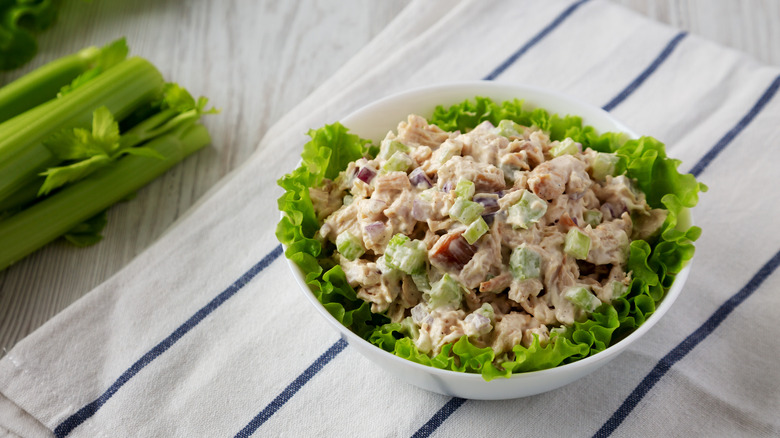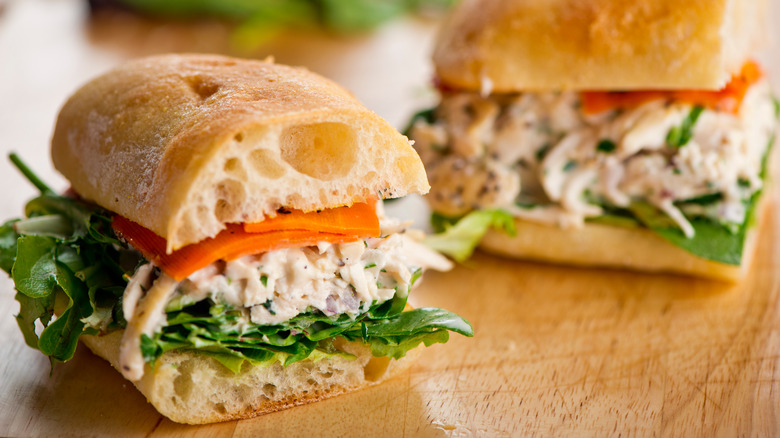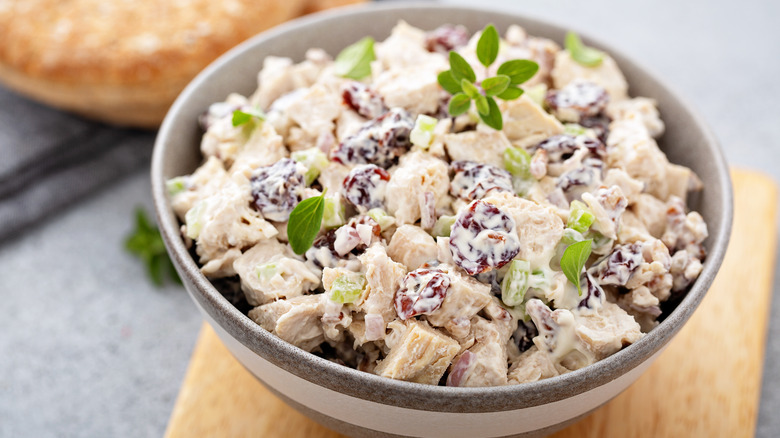How Long Chicken Salad Actually Lasts In The Fridge
Keeping a batch of homemade chicken salad in the fridge means there is always something delicious to eat. But once you've shredded your chicken, chopped your add-ins, and mixed in mayo, you only have three to four days to enjoy it, according to the U.S. Department of Agriculture (USDA). Two main ingredients in chicken salad are ripe for harboring bacteria: cooked chicken and mayo. If you like fresh vegetables or fruits like apples with your chicken salad, these can also spoil in just a few days. The bacteria may make you sick or affect the taste and texture of your dish, and of course, neither is desirable.
Chicken salad also shouldn't sit out of the fridge for more than two hours at a time. The USDA has designated a temperature range called the Danger Zone, between 40 degrees and 140 degrees Fahrenheit. Bacteria rapidly multiply in this range, so you want to keep cold food at 40 degrees or below and hot food at 140 degrees or above. Perishable cold foods like mayo-based salads can't sit out at room temp for long.
Keeping that Danger Zone in mind, it's best not to let your chicken salad sandwich sit in a lunchbox all morning without proper ice packs, or leave your salad out in the hot sun at a picnic, for that matter. And given its short shelf life, you might avoid cooking chicken salad in huge quantities, unless you know you'll eat it all within a few days.
How to keep your chicken salad safe as long as possible
Several factors encourage bacteria to multiply on your food: temperature, oxygen, time, lack of acidity, and moisture. A multi-pronged approach to combat all five will help keep germs at bay and your chicken salad safe. To tackle temperature, store your chicken salad in the coldest spot in the fridge. Usually, this is in the back or bottom. It is definitely not in the door, which is opened frequently and exposed to warm outside air.
An airtight seal on whatever bag or container you use to store your salad will lock out oxygen and moisture. When it comes to acidity, bacteria love a neutral pH environment. Adding an acid to your recipe can help — this could be a splash of vinegar or citrus juice (plus, you get a bonus dash of flavor).
Unfortunately, the time factor is out of your control, but an obvious move is to limit the time your salad spends in the Danger Zone. Once bacteria enter their comfy and preferred temperature range, they can double in number after just 20 minutes. Your salad won't be dangerous to eat, but its total shelf life will likely decrease.
How to tell if your chicken salad is past its prime
There are obvious signs that you shouldn't consume chicken salad, beyond taking a bite and feeling your stomach turn. If it smells bad, looks gray or off-color, or there is visible mold growing, into the garbage bin it goes. If it looks slimy or watery, it probably isn't safe to eat, either. However, some sneaky types of bacteria can't be picked up by your senses — not even taste. These bacteria, known as pathogens, are the ones that can land you in the emergency room. So, testing the boundaries of that USDA-designated four day rule is never a good idea.
You may be wondering how other types of deli-style salads hold up. Unfortunately, the same safety pitfalls and parameters apply to all mayo-based salads, so whether it's potato, egg, macaroni, or tuna, you'll want to store them in the same way as chicken salad. The number of days each type of salad lasts may vary slightly depending on moisture — the more water content a food contains, the more hospitable it is to bacteria. If you prepare your chicken salad at home, start the shelf life clock as soon as you're done making it. If it's store-bought, heed the manufacturer's expiration date.



